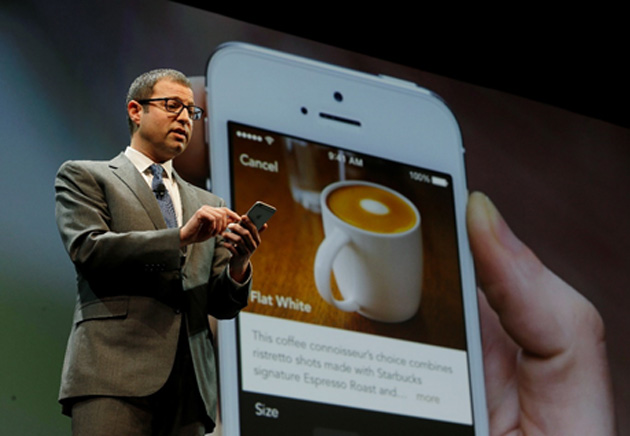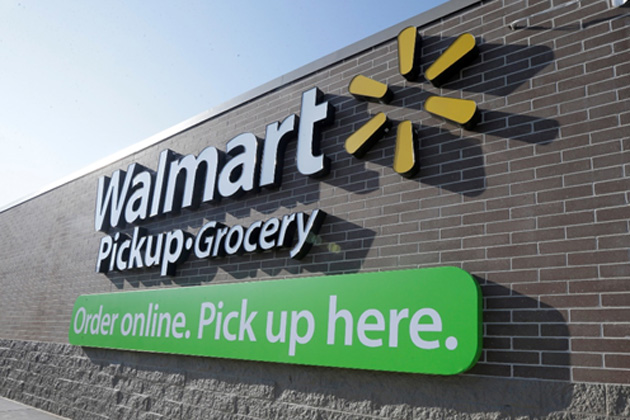I like Starbucks. That’s not the same as liking Starbucks coffee. I think their coffee is fine, but I’m not a connoisseur. I just like it hot and caffeinated.
Combine the coffee with their store environment, though, and the attraction is clearer. There are good reasons Starbucks went from a local Seattle shop to worldwide brand in record time.
You could say the same for other companies, of course. But today, we’ll discuss Starbucks (SBUX) because it is doing something unique. Thinking about it after my e-commerce pricing story last month, I realized the online retail vs. bricks-and-mortar conflict isn’t as clearly defined as it might seem.

Magical App
My Starbucks habit began when I lost my last corporate job and took up freelance writing. The local Starbucks was a comfortable place to work. It was rarely crowded except for the morning rush, and they had reliable Wi-Fi and power outlets. Not wanting to be a freeloader, I always bought some coffee.
Now that I have a home office and the nearest Starbucks is 15 miles away, I only go on weekends. But the Starbucks app on my phone keeps nudging me to come more often.
The very handy smartphone app will guide you to the nearest store and hold your gift card balances. At the register, they just scan your phone and you’re done.
Better yet, the app now has mobile ordering. Before you even get there, you can order your drink—customized however you like—and it will be waiting on the counter for you. You just walk in and grab it. Magic.
This is where it gets interesting: The Starbucks loyalty program ties into the app too, using points to incentivize behavior, much like online merchants do.
It does this by sending personalized promotion offers.
This new approach to retail marketing isn’t the old shotgun advertising (pull the trigger and hope you hit something). It’s a sniper rifle aimed right at my weak spot.

Personalized Promotions
Standard retail promotions—10% off, 2 for 1, etc.—have lost a lot of their bite.
They may or may not work. Some people would have bought the product anyway, even without a discount. Others didn’t buy, but would have if the discount were just a little more or offered on a different day.
What if the store could offer each customer precisely what it takes to make them buy, and not a penny more? That’s kind of what Starbucks is doing.
Every month or so, they send me an offer that says, “Buy these three products in the next week and get 100 Bonus Stars.” Normally, you would have to spend $50 to earn 100 stars. So this isn’t a negligible amount of money.
There’s a pattern to the three products too. Two are always items I bought recently. The third one will be something I’ve never bought before. They offer me a reward for trying it… and it usually works.
Another sales tactic is the “Star Dash.” It awards escalating bonus stars for making multiple visits in a defined period. That one never works for me because I am near a Starbucks only on weekends. But they keep trying.
You can infer the goals here: Frequency of visit and average ticket size are key metrics for any retailer. The Starbucks app tracks those by customer. Then the loyalty program offers individualized incentives.
This is remarkably similar to the way online retailers customize prices and promotions based on customer data. But it’s happening in a physical store.

Hybrid Models
The retail sector battle isn’t black and white, stores vs. online. While that’s part of it, drawing the line is getting harder.
Chain stores are now exploring ways to integrate e-commerce with their store networks. At Nordstrom (JWN), salespeople carry tablets that list every store’s inventory. If you want those shoes, but they don’t have your size in stock, no problem. A few taps, and a Nordstrom store across the country will ship them right to you.
How do we classify that transaction—store or online? Is Nordstrom a traditional retailer or e-commerce? It’s both - or maybe neither.
Walmart (WMT) offers store pickup for online orders. Last month, it launched a “Pickup Discount” program where you actually get lower prices for items bought that way.

There’s another element to this: supply chain efficiency.
If a chain store advertises a sale in traditional media, it has to make sure every location is stocked up on that item.
Contrast that with the Starbucks app giving every customer their own personal sale days. They can coordinate it with inventory planning and smooth out the peaks. Small savings add up over thousands of stores.
The bigger point here is that retailers are not surrendering to the Amazon (AMZN) juggernaut. They are fighting back with whatever advantages they have. And they do have some, as we see in the Nordstrom and Walmart hybrid models
For investment strategy, it means that some beaten-up retail stocks may have more value than we think.
Likewise, I suspect we’ll see new real estate opportunities as the economy finds the right balance of storefront, mall, and warehouse space. Companies that supply retailers with efficient technology and logistical services may also have good prospects.
Finding those opportunities isn’t easy, of course. But success never is.
Disclosure: Follow Mauldin as he uncovers the truth behind, and beyond, ...
more
Disclosure: Follow Mauldin as he uncovers the truth behind, and beyond, the financial headlines in his free publication, Thoughts from the Frontline. The publication explores developments overlooked by mainstream news to help you understand what’s happening in the economy and navigate the markets with confidence.
The article was excerpted from John F. Mauldin’s Thoughts from the Frontline.
Copyright 2016. Follow John Mauldin on Twitter.
The article How Big the Gig Economy Really Is was originally published at mauldineconomics.com.
To subscribe to John Mauldin's Thoughts from the Frontline e-newsletter and a selection of other free newsletters, please click here:& ;http://www.mauldineconomics.com/subscribe
To change your email address, please click here: http://www.mauldineconomics.com/change-address
Thoughts From the Frontline and MauldinEconomics.com is not an offering for any investment. It represents only the opinions of John Mauldin and those that he interviews. Any views expressed are provided for information purposes only and should not be construed in any way as an offer, an endorsement, or inducement to invest and is not in any way a testimony of, or associated with, Mauldin's other firms. John Mauldin is the Chairman of Mauldin Economics, LLC. He also is the President and registered representative of Millennium Wave Advisors, LLC MWA which is an investment advisory firm registered with multiple states, President and registered representative of Millennium Wave Securities, LLC, (MWS) member FINRA and SIPC, through which securities may be offered. MWS is also a Commodity Trading Advisor (CTA) registered with the CFTC, as well as an Introducing Broker (IB) and NFA Member. Millennium Wave Investments is a dba of MWA LLC and MWS LLC. This message may contain information that is confidential or privileged and is intended only for the individual or entity named above and does not constitute an offer for or advice about any alternative investment product. Such advice can only be made when accompanied by a prospectus or similar offering document. Past performance is not indicative of future performance. Please make sure to review important disclosures at the end of each article. Mauldin companies may have a marketing relationship with products and services mentioned in this letter for a fee.
Note: Joining The Mauldin Circle is not an offering for any investment. It represents only the opinions of John Mauldin and Millennium Wave Investments. It is intended solely for investors who have registered with Millennium Wave Investments and its partners at www.MauldinCircle.com (formerly AccreditedInvestor.ws) or directly related websites. The Mauldin Circle may send out material that is provided on a confidential basis, and subscribers to the Mauldin Circle are not to send this letter to anyone other than their professional investment counselors. Investors should discuss any investment with their personal investment counsel. John Mauldin is the President of Millennium Wave Advisors, LLC MWA, which is an investment advisory firm registered with multiple states. John Mauldin is a registered representative of Millennium Wave Securities, LLC, (MWS), an FINRA registered broker-dealer. MWS is also a Commodity Trading Advisor (CTA) registered with the CFTC, as well as an Introducing Broker (IB). Millennium Wave Investments is a dba of MWA LLC and MWS LLC. Millennium Wave Investments cooperates in the consulting on and marketing of private and non-private investment offerings with other independent firms such as Altegris Investments; Capital Management Group; Absolute Return Partners, LLP; Fynn Capital; Nicola Wealth Management; and Plexus Asset Management. Investment offerings recommended by Mauldin may pay a portion of their fees to these independent firms, who will share 1/3 of those fees with MWS and thus with Mauldin. Any views expressed herein are provided for information purposes only and should not be construed in any way as an offer, an endorsement, or inducement to invest with any CTA, fund, or program mentioned here or elsewhere. Before seeking any advisor's services or making an investment in a fund, investors must read and examine thoroughly the respective disclosure document or offering memorandum. Since these firms and Mauldin receive fees from the funds they recommend/market, they only recommend/market products with which they have been able to negotiate fee arrangements.
PAST RESULTS ARE NOT INDICATIVE OF FUTURE RESULTS. THERE IS RISK OF LOSS AS WELL AS THE OPPORTUNITY FOR GAIN WHEN INVESTING IN MANAGED FUNDS. WHEN CONSIDERING ALTERNATIVE INVESTMENTS, INCLUDING HEDGE FUNDS, YOU SHOULD CONSIDER VARIOUS RISKS INCLUDING THE FACT THAT SOME PRODUCTS: OFTEN ENGAGE IN LEVERAGING AND OTHER SPECULATIVE INVESTMENT PRACTICES THAT MAY INCREASE THE RISK OF INVESTMENT LOSS, CAN BE ILLIQUID, ARE NOT REQUIRED TO PROVIDE PERIODIC PRICING OR VALUATION INFORMATION TO INVESTORS, MAY INVOLVE COMPLEX TAX STRUCTURES AND DELAYS IN DISTRIBUTING IMPORTANT TAX INFORMATION, ARE NOT SUBJECT TO THE SAME REGULATORY REQUIREMENTS AS MUTUAL FUNDS, OFTEN CHARGE HIGH FEES, AND IN MANY CASES THE UNDERLYING INVESTMENTS ARE NOT TRANSPARENT AND ARE KNOWN ONLY TO THE INVESTMENT MANAGER. Alternative investment performance can be volatile. An investor could lose all or a substantial amount of his or her investment. Often, alternative investment fund and account managers have total trading authority over their funds or accounts; the use of a single advisor applying generally similar trading programs could mean lack of diversification and, consequently, higher risk. There is often no secondary market for an investor's interest in alternative investments, and none is expected to develop. You are advised to discuss with your financial advisers your investment options and whether any investment is suitable for your specific needs prior to making any investments.
All material presented herein is believed to be reliable but we cannot attest to its accuracy. Opinions expressed in these reports may change without prior notice. John Mauldin and/or the staffs may or may not have investments in any funds cited above as well as economic interest. John Mauldin can be reached at 800-829-7273.
less







